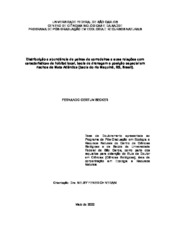| dc.contributor.author | Becker, Fernando Gertum | |
| dc.date.accessioned | 2016-06-02T19:29:27Z | |
| dc.date.available | 2004-08-14 | |
| dc.date.available | 2016-06-02T19:29:27Z | |
| dc.date.issued | 2002-05-29 | |
| dc.identifier.citation | BECKER, Fernando Gertum. Distribuição e abundância de peixes de corredeiras e suas relações com características de hábitat local, bacia de drenagem e posição espacial em riachos de Mata Atlântica (bacia do rio Maquiné, RS, Brasil.. 2002. 201 f. Tese (Doutorado em Ciências Biológicas) - Universidade Federal de São Carlos, São Carlos, 2002. | por |
| dc.identifier.uri | https://repositorio.ufscar.br/handle/ufscar/1684 | |
| dc.description.abstract | The relationship between fish, local habitat, catchment characteristics spatial position
in riffles of the Maquiné river basin (RS, Brazil) was studied. Results were discussed
considering present and historical states of conservation of the basin, which was determined from Landsat TM5 images. Fish data were obtained from qualitative sampling and quantitative sampling. The later involved standardized kick-sampling in 24 riffles. Sampling occurred seasonally from August 1999 to June 2000. A total of 72 fish species occur at the Maquiné river basin. Only 3 species occur at the headwaters, 1 at the slope of the Serra Geral and 68 from valley bottoms to the river mouth. Among the later, 20 occur exclusively in valley bottom stream sections and not in Coastal Plain habitats. From these, 8 benthic riffle species were investigated for relations with habitat and catchment characteristics. The spatial pattern of assemblage variation allowed the description of four assemblage types:
a)assemblages dominated by Hemipsilichthys spp; b) with high relative abundance of
Hemipsilichthys spp, but other species being also abundant, c) with intermediary total
abundance, dominated by R. aequalicuspis, E. bilineatus and C. pterostictum; d) with low
total abundance, dominated by R. aequalicuspis. Assemblages were seasonally persistent
and proportional abundance was stable. Although local habitat characteristics have
significantly contributed to explain variation in the data, the observed patterns reflected the
control of catchment characteristics over local habitat and fish assemblages. Although spatial position was important both at the individual stream and basin scales, assemblage
characteristics were also related to catchment area. The state of conservation at the
catchment scale did not present evident relationships with fish assemblage characteristics and some hypothesis explaining this finding are discussed. The present process of vegetation recovery, the relatively high number of species and the biogeographic situation of the Maquiné basin indicate that it should be contemplated in conservation programs. Theregion is promising for investigating how lotic ecosystems respond to landscape recovery in their catchments. | eng |
| dc.description.sponsorship | Financiadora de Estudos e Projetos | |
| dc.format | application/pdf | por |
| dc.language | por | por |
| dc.publisher | Universidade Federal de São Carlos | por |
| dc.rights | Acesso Aberto | por |
| dc.subject | Peixes | por |
| dc.subject | Riachos | por |
| dc.subject | Habitat | por |
| dc.subject | Bacias hidrográficas | por |
| dc.subject | Distribuição espacial. | por |
| dc.subject | Ictiologia | por |
| dc.title | Distribuição e abundância de peixes de corredeiras e suas relações com características de hábitat local, bacia de drenagem e posição espacial em riachos de Mata Atlântica (bacia do rio Maquiné, RS, Brasil. | por |
| dc.type | Tese | por |
| dc.contributor.advisor1 | Verani, Nelsy Fenerich | |
| dc.contributor.advisor1Lattes | http://genos.cnpq.br:12010/dwlattes/owa/prc_imp_cv_int?f_cod=K4788117U4 | por |
| dc.description.resumo | São analisadas as relações entre peixes de corredeiras,hábitat local, fisiografia da bacia e posição espacial. Os resultados foram discutidos diantedos contextos atual e histórico de conservação da bacia do rio Maquiné (RS), determinado com base em análise de imagens do satélite Landsat TM 5. Foram realizadas amostras qualitativas e quantitativas de peixes, sendo as quantitativas realizadas em 24 trechos de corredeiras, entre agosto/1999 e junho/2000. A bacia apresenta 72 espécies de peixe. Apenas 3 ocorrem nas cabeceiras, 1 na encosta, e sua distribuição não se sobrepõe com as 68 restantes, distribuídas dos fundos de vale até a foz. Vinte espécies ocorrem exclusivamente nos fundos de vale. Destas, 8 foram alvo das análises de relação com hábitat e características de bacia. Podem ser descritos quatro tipos de assembléia, relativamente persistentes e estáveis ao longo do ano: a) dominadas por Hemipsilichthys sp. e/ou H. nudulus; b) com abundância elevada Hemipsilichthys spp, mas também de algumas outras espécies, c) com mediana abundância total de indivíduos, principalmente R. aequalicuspis, E. bilineatus e C. pterostictum; d) com baixa abundância total de indivíduos, dominadas por R. aequalicuspis. Embora características de hábitat local tenham contribuído para a explicação dos padrões de variação, observou-se que os padrões refletem o controle primário de processos de bacia sobre hábitat local e assembléias de peixes. A influência da fisiografia se dá independentemente da posição espacial do riacho na bacia, estando as variações das assembléias associadas ao eixo longitudinal da bacia do rio Maquiné e também das subbacias, dependendo do tamanho do riacho. Não foi observada influência do grau de antropização atual das sub-bacias sobre as assembléias de peixes, e levanta-se hipótesespara explicar esse fato. O atual processo de recuperação da vegetação, número relativamente alto de espécies e a importância biogeográfica indicam que a bacia do rio Maquiné deve ser alvo de medidas de conservação e recuperação, além de investigações sobre como ecossistemas lóticos respondem à recuperação da vegetação da bacia. | por |
| dc.publisher.country | BR | por |
| dc.publisher.initials | UFSCar | por |
| dc.publisher.program | Programa de Pós-Graduação em Ecologia e Recursos Naturais - PPGERN | por |
| dc.subject.cnpq | CIENCIAS BIOLOGICAS | por |
| dc.contributor.authorlattes | http://genos.cnpq.br:12010/dwlattes/owa/prc_imp_cv_int?f_cod=K4784950Z0 | por |
